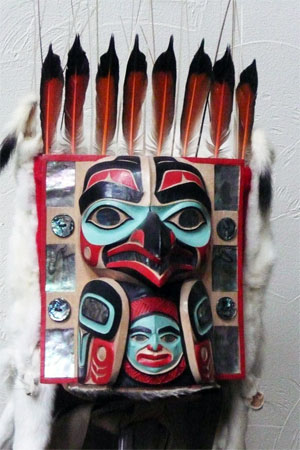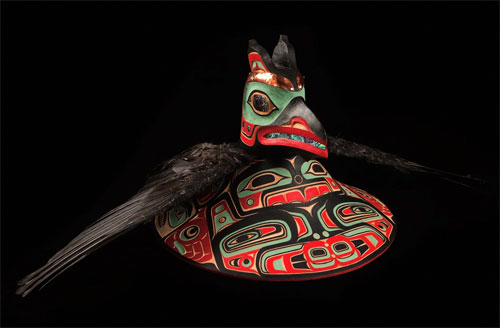
Tlingit Artist Tells Cautionary Tale About Use of Feathers in Art
October 17, 2012
Cavanaugh says he did not know he was prohibited by two federal laws from using flicker feathers and raven feathers on pieces for sale, and he wants other Native artists to know they could be in legal peril as well. “It was devastating, it was depressive. It was hurtful, painful, for a carver - a Tlingit - to go through what I did, not knowing it was a law,” Cavanaugh said. “So many of our people use these materials and they’re not aware that selling them is prohibited. The use of flicker feathers is an ancient practice,” said Sealaska Heritage Institute President Rosita Worl. “And as far as we’re aware, flicker feathers come from birds that are not endangered.” Cavanaugh’s ordeal began when an agent with the U.S. Fish and Wildlife Service recently contacted him, saying the artist could face prison time and substantial fines because he was attempting to sell online a shakee.át (headdress) adorned with flicker feathers and a hat that had raven feathers on it. He says a farmer in the Lower 48 gave the flicker feathers to him and an animal control officer gave the raven feathers to him. Cavanaugh faced charges under the Migratory Bird Treaty Act for attempted sale of the flicker feathers and under the Lacey Act for attempted sale of the raven feathers. He hired a lawyer and settled the case in October, agreeing to pay a $2,000 fine with no prison time. He also was forced to strip the feathers from his pieces and hand them over to the agency. Cavanaugh says he complied to avoid prison time and a financially devastating fine, but he doesn’t understand why he isn’t allowed to sell especially items adorned with flicker feathers, which are found on ancient pieces. A revered Tlingit carver from Wrangell named Kaajisduáx.ch (Man For You To Hear) sold such pieces, he said. “He came from Wrangell all through Southeast doing all kinds of art projects for people, for tribes, for clans and he never did it for free. He was always paid tináa (copper shields),” he said. The bottom line for Native people is Native artists cannot sell pieces adorned with feathers from birds protected under federal law - even if they are selling the pieces to other Native people as a clan’s at.óow (sacred clan objects) for use in ceremonies. In such a case, both the Native artist and the Native buyer could face felony charges.
Before: Raven Hat with Raven Feathers
Sealaska Heritage Institute will be working with the Alaska Federation of Natives (AFN) to introduce a resolution on the matter at its convention this week. The resolution would support a federal amendment to exempt Native handicrafts from the prohibition on the sale or purchase of nonedible parts of migratory birds that were taken for subsistence purposes, said SHI President Rosita Worl. It would be almost identical to an exemption in the handicraft language in the Marine Mammals Protection Act, Worl said. A federal policy announced last week by the U.S. Dept. of Justice is a step in the right direction, but the sale of Native art adorned with feathers of federally protected birds is still prohibited, she said. “I’m just hoping Don Young, Murkowski, Begich will address this with our help, with AFN’s help, that they can put an amendment to this act that will give us the right to be Native people, to create artifacts that have been done for 10,000 years.” The practice also would help Native people in economically depressed communities earn an income, Worl said. Sealaska Heritage Institute was founded in 1980 to promote cultural diversity and cross-cultural understanding. The institute is governed by a Board of Trustees and guided by a Council of Traditional Scholars.
Edited by Mary Kauffman, SitNews
Source of News & Photographs:
E-mail your news &
photos to editor@sitnews.us
|
|||

